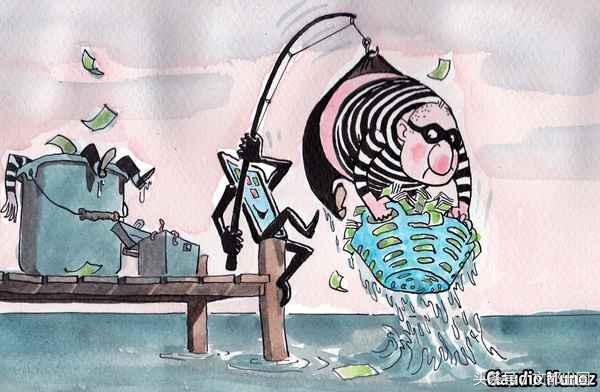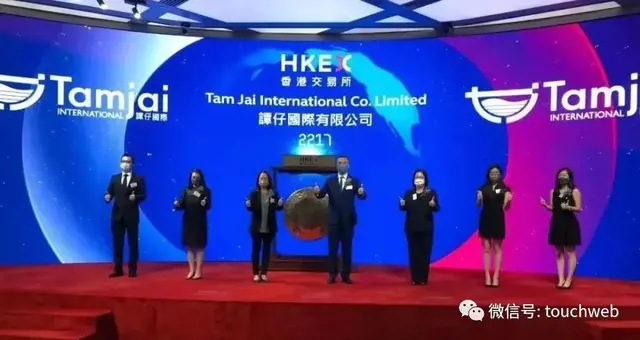2018.1.17经济学人官译:反洗钱技术
Anti-money-laundering technology
Washing whiter
Software is patrolling the financial system, looking for crooks
反洗钱技术
洗白白
软件在金融系统中巡逻,寻找犯罪分子的踪迹

KEEN, no doubt, to stay alive, drug traffickers tend to be prompter payers than most. For software firms, this is just one of many clues that may hint at the laundering of ill-gotten money. Anti-money-laundering (AML) software, as it is called, monitors financial transactions and produces lists of the people most likely to be transferring the proceeds of crime.
毒贩无疑觉得保命要紧,因此他们往往比大多数人付款更快。对于软件公司来说,这只是暗示可能有不法分子在洗钱的许多线索之一。顾名思义,反洗钱(AML)软件监控金融交易并生成名单,列出最有可能是在转移犯罪所得的人。
Spending on this software is soaring. Celent, a research company, estimates that financial firms have spent roughly $825m on it so far this year, up from $675m last year. Technavio, another research firm, reckons the market is even bigger and will grow at more than 11% annually in coming years. This is partly because authorities are increasingly quick to punish institutions that let down their guard. Deutsche Bank, for example, has been hit with fines worth at least $827m this year alone. Governments, eager to appear tough on crime, are urging prosecutors to go after not just institutions, but also their employees.
在这类软件上的花费正在飙升。研究公司Celent估计,今年迄今为止,金融公司在这方面已投入约8.25亿美元,去年为6.75亿美元。另一家研究公司Technavio认为这一市场还要更大,且未来几年将以每年11%以上的速度增长。原因之一是监管机构在惩罚放松警惕的金融机构时动作越来越快。例如,德意志银行今年一年就受到至少8.27亿美元的罚款。各国政府急于在打击犯罪方面显示强硬姿态,敦促检察官不但要追究金融机构的责任,还要追究雇员个人。
The number of anti-laundering regulations is climbing yearly—by nearly 10% in America, Canada and the EU, and by roughly 15% in Australia, Hong Kong, Malaysia and Singapore, says Neil Katkov, a regulatory analyst at Celent. Even the red-tape-slashing administration of President Donald Trump is unlikely to cut regulation in this area.
Celent的监管分析师尼尔·卡特科夫(Neil Katkov)表示,反洗钱法规的数量在逐年攀升,美国、加拿大和欧盟每年上升近10%,澳大利亚、香港、马来西亚和新加坡大约上升15%。即使是要大幅去监管的特朗普政府也不可能削弱这方面的监管。
David Stewart, head of anti-money-laundering systems at SAS, a software giant based in North Carolina, reckons that efforts to abide by such rules now take from a half to about 70% of most banks’ entire spending on compliance. A survey this year by Duff & Phelps, an advisory group, found that financial firms typically spend about 4% of revenue on compliance, a figure expected to reach 10% in 2022.
大卫·斯图尔特(David Stewart)是北卡罗莱纳州软件巨头SAS公司的反洗钱系统主管。他认为,现在遵守这些法规的工作占到大多数银行合规总支出的一半到70%左右。咨询公司道衡(Duff & Phelps)今年的一项调查显示,金融公司通常将收入的4%用于合规,预计到2022年这一数字将达到10%。
Many clues that lead software to block a transaction, or to flag it for a human to investigate, are straightforward. Round sums are more suspect than jagged ones. Spikes in transaction volumes and amounts are suspicious. So is cash deposited in an account via multiple branches. An area’s culture also matters. Sasi Mudigonda, of Oracle, says its software considers transactions linked to eastern Ukraine riskier than the west of the country, where Russian influence is weaker. Even age counts—crooks who move money disproportionately steal the identities of old people and young adults, says Michael Kent, chief executive of Azimo, a remittances firm.
一些线索会引导软件阻止交易,或者标记可疑之处以待人工调查。它们大多很简单:整数比有零有整的数目更可疑;交易量和金额突然增加很可疑;现金通过多个分行存入一个账户同样可疑。一个地区的文化也很重要。甲骨文公司的萨希·穆迪岗达(Sasi Mudigonda)说,甲骨文的软件认为与乌克兰东部有关的交易风险高于该国西部,因为俄罗斯对后者的影响力较弱。就连年龄也与风险水平有关。汇款业务公司Azimo的首席执行官迈克尔·肯特(Michael Kent)说,转移钱财的犯罪分子会大量盗用老人和年轻人的身份。
Software also hunts for clues that someone on one of hundreds of watch lists has concocted a fake identity—the giveaway could be the opening of an account with a password or phone number once used by a corrupt official. ComplyAdvantage, a firm based in London, licenses software that generates long lists of suspected criminals by sifting through hundreds of millions of articles, including those in The Economist, and then determines which transactions may benefit one of them.
软件还会寻找线索,判断数百份监控名单之一列出的某个人是否已伪造了假身份,露馅的线索可能是此人开具银行账户时用了曾属于某腐败官员的密码或电话号码。伦敦公司ComplyAdvantage授权客户使用的软件会详查包括《经济学人》文章在内的数千万篇文章,生成长串的可疑犯罪分子名单,然后判断哪些交易可能会让其中的某人受益。
Moving the proceeds of big-ticket crime conventionally involves disguising them as legitimate trade payments. Software from a Singaporean firm, AML360, is designed to flag instances of this. Daniel Rogers, the company’s boss, says it monitors “a jigsaw puzzle” of factors such as ship itineraries, the locations of commodity producers and fluctuations in their prices. The software notices if a firm imports expensive stainless steel when a cheaper source of the material is closer at hand, say, or if an importer’s spending on copper rises as its price falls.
把高案值犯罪所得包装成合法贸易所得进行转移是常见做法。新加坡公司AML360的软件就专门对此类交易加标注。公司老板丹尼尔·罗杰斯(Daniel Rogers)表示,该软件会监控“拼图图块”般的各种因素,如船舶行程、商品生产者所在地和价格波动等。如果一家公司明明在国内就能买到比较便宜的不锈钢,却选择高价进口,或者铜价下跌时进口商的进口额反而升高,这些异常都会被软件察觉。
The next step for AML software is a big leap in the amount and types of data it crunches. Last year SAS launched Visual Investigator, developed at a cost of about $1bn. It links financial transactions with text and even imagery in reams of social media. This could reveal, for example, that a restaurant’s cash deposits appear too large for the amount of online “buzz” the business generates; or that a payment recipient skis with a kleptocrat.
反洗钱软件发展的下一步是在所处理数据的数量和类型上实现重大飞跃。去年,SAS推出了“视觉侦探”(Visual Investigator)软件,开发成本约为10亿美元。这款软件能将金融交易与社交媒体中的文本甚至图像联系起来。这能揭示很多线索,例如,相对其在网络上的低“人气”而言,某家餐馆的现金存款太多;或者某笔付款的收款人和一个贪官一起滑雪。
With SAS software, rather more than half of flagged transactions lead to the filing of a suspicious-activity report (SAR) with authorities. Monique Melis, head of regulatory consulting at Duff & Phelps in London, argues that, to reduce “false positives” further, regulators should begin systematically to disclose the SARs that lead to a discovery of crime. Software could then be better calibrated to withstand a growing problem highlighted by Sophie Lagouanelle of FircoSoft, a Paris developer of AML technology: savvy launderers are learning how the software works to slip past it.
在被SAS软件标记出来的交易中,一多半最终由工作人员向监管部门提交了可疑活动报告(SAR)。在伦敦的道衡主管监管咨询的莫妮克·梅里斯(Monique Melis)认为,为了进一步减少“误报”,监管机构应该系统地披露是哪些SAR报告帮助发现了犯罪行为。这样就可以更好地校准软件,抵御一个日益严重的问题——巴黎AML技术软件开发商FircoSoft的索菲·拉古阿奈拉(Sophie Lagouanelle)强调说,精明的洗钱者正在学习软件的工作方式,以躲避监督。
Should human analysts fear for their jobs? Probably not. They will still be needed to follow up on many flagged transactions. Business has not slowed for Berlin Risk, a German consultancy that discreetly investigates the nature of a person’s character and earnings by talking to as many as 20 people who know him. As its senior partner, Carsten Giersch, puts it, “You will never see a robot interviewing sources.” Or is that the next step?
人类分析员应该担心自己的工作吗?可能不用。很多被标记的交易仍然需要人类分析员跟进。德国咨询公司Berlin Risk的业务就没有减少。该公司谨慎地调查一个人的品性和收入情况,为此会与多达20个认识他的人交谈。正如其高级合伙人卡斯丹·吉尔奇(Carsten Giersch)所说:“你永远也不会看到机器人去询问消息提供者。”或者这是下一步的发展方向?




















评论